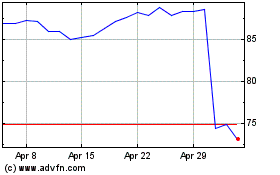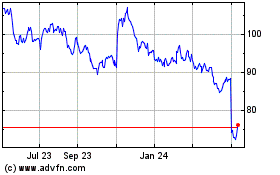By Alexandra Wexler
JOHANNESBURG-- Starbucks Corp. on Thursday joined the deluge of
international food and retail chains establishing a presence in
South Africa, in an effort to tap the continent's expanding
consumer class.
The Seattle-based coffee chain is the latest in a string of
big-name franchises and retailers of everything, from pizza to
skinny jeans, to open doors in the continent's second-largest
economy after Nigeria, long seen as a gateway to African
markets.
The company's first retail store in sub-Saharan Africa, where it
sources coffee from nine countries, opened in a posh shopping
district of Johannesburg on Thursday, where people had been lined
up since 6 a.m.
Prince Ndlovu, a 26-year-old music artist manager who heard
about the opening on Facebook, waited more than two hours for his
Grande cappuccino. "For a beautiful thing, you need to wait," said
the Zimbabwean native, who on Thursday tasted a Starbucks coffee
for the first time.
"It's more than what I was expecting," said Yahya Madhi, 21,
another first-time customer.
The move aims to give the coffee giant a firm foothold in a
region replete with opportunity and risk.
Executives see South Africa as a steppingstone into a continent
that housed three of the world's five fastest-growing economies in
2015, according to the World Bank.
But Starbucks' move comes at a time when South Africa, like many
commodity-rich nations across the continent, is struggling to grow
its economy amid myriad issues ranging from government missteps to
social unrest and drought. Many retailers, like South Africa-based
Massmart Holdings Ltd., which is majority-owned by Wal-Mart Stores
Inc., have tried to expand out into the broader continent in recent
years, but have run into roadblocks that have significantly slowed
their progress.
Some brands have also struggled to recalibrate to a market very
different from the U.S. or Europe. In South Africa, Spain's Zara,
owned by Inditex SA, opened its first retail outlet in Johannesburg
in late 2011, but growth hasn't been too robust.
"In the South African context, it's actually quite expensive,"
said Unathi Loos, retail analyst at Investec Asset Management in
Cape Town. "It's fallen into a completely different category here
than it has abroad."
However, Ms. Loos doesn't fear the same fate for Starbucks.
"There's quite a coffee culture that is developed in South Africa.
People are willing to part with a good amount of money for a good
cup of coffee."
South Africa was historically under-penetrated by international
brands, which avoided the country due to international sanctions
during apartheid rule, which ended in 1994. But recent decades have
seen an influx of investment into the country's major cities, which
draw well-to-do shoppers from elsewhere on the continent because of
well-developed roads and a comparatively wide range of retailers,
from mass-discount stores to high-end international brands.
Taste Holdings Ltd., which is the licensee for South Africa's
Starbucks stores, also has a licensee deal with Domino's Pizza in
Southern Africa, where it now operates more than 75 stores, the
first of which opened in late 2014. Swedish retailer Hennes &
Mauritz AB opened its first H&M stores in South Africa late
last year, and Krispy Kreme Doughnuts, Inc. plans to open more than
30 outlets in South Africa within five years, the first of which
arrived in late 2015.
But expanding on the continent has proved difficult for many
blue-chip retailers. When Wal-Mart acquired a majority stake worth
about $2.4 billion in Massmart in 2011, the former had hoped to
rapidly expand Massmart's low-cost, high-volume chains outside of
South Africa.
Yet Massmart's planned expansion to the broader continent has
been slower than expected; partly because of the amount of time it
takes to acquire land and proper licenses, according to Guy
Hayward, the company's chief executive. Massive fluctuations in
African currencies have also undermined efforts to expand across
the region.
In 2011, the company had 313 stores, 26 of which were outside
South Africa. At the end of 2015, Massmart's 403 stores included 38
stores outside South Africa.
South Africa itself still presents many challenges. The country
grew an anemic 1.3% last year and is expected to grow just 1.4% in
2016, according to the World Bank.
In December, President Jacob Zuma replaced the country's finance
minister twice in a four-day period, sending South Africa's rand
currency plunging to all-time lows against the U.S. dollar and
British pound.
That put additional pressure on businesses, including retailers,
which rely heavily on imports. Foreign direct investment in South
Africa plummeted from 62.6 billion rand ($4.38 billion) in 2014 to
22.6 billion rand last year. Currency weakness has also sparked
higher inflation, which means consumers have less money to spend on
things like sweaters and pumpkin-spiced lattes.
Strikes have plagued mines and factories as well as public
services like garbage collection, firefighters and the postal
service, while a dilapidated power grid prompted nationwide rolling
blackouts for months last year. And now, a record-breaking regional
drought is threatening agricultural output, food security and water
supplies.
Starbucks plans to open just 12 to 15 South African stores in
the next two years, despite an estimated capacity of 150 stores,
Carlo Gonzaga, chief executive of Taste Holdings, Starbucks'
licensee in South Africa, said on Wednesday.
"There's the expectation that consumption per capita will just
increase exponentially, but in the short term, it's hard to see why
people would be excited about consumer expenditure," said Meryl
Pick, an analyst at Old Mutual Equities. "In 15 years' time, these
might look like good investments."
Write to Alexandra Wexler at alexandra.wexler@wsj.com
(END) Dow Jones Newswires
April 21, 2016 08:03 ET (12:03 GMT)
Copyright (c) 2016 Dow Jones & Company, Inc.
Starbucks (NASDAQ:SBUX)
Historical Stock Chart
From Mar 2024 to Apr 2024

Starbucks (NASDAQ:SBUX)
Historical Stock Chart
From Apr 2023 to Apr 2024
